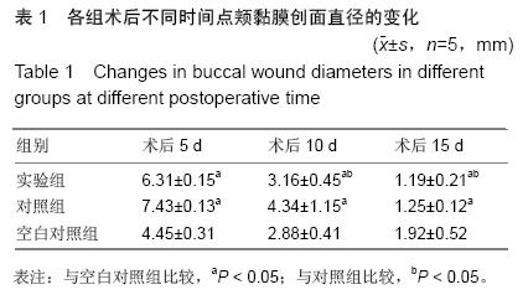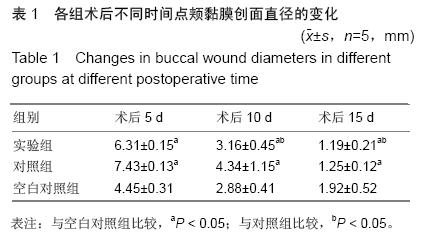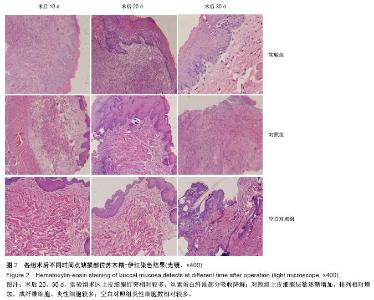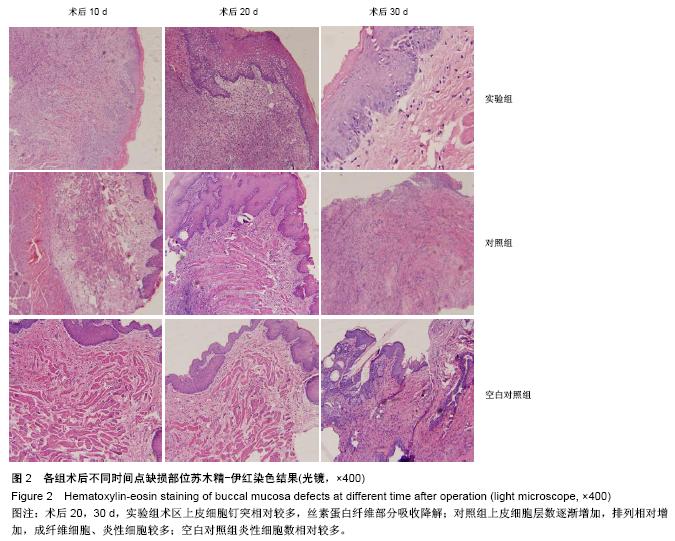| [1] 王海燕,周咏梅,吴岚,等.以胶原膜为支架构建组织工程化人口腔黏膜研究[J].临床口腔医学杂志,2009,25(8): 494-496.[2] Monteiro IP,Shukla A,Marques AP,et al.Spray-assisted layer-by-layer assembly on hyaluronic acid scaffolds for skin tissue engineering.J Biomed Mater Res A.2015; 103(1):330-340.[3] N Laird D,Mucalo M,Dias G.Vacuum-assisted infiltration of chitosan or polycaprolactone as a structural reinforcement for sintered cancellous bovine bone graft.J Biomed Mater Res A.2012;100A(8): 2018-2026.[4] Chen LL,Hu GF.Angiogenin-mediated ribosomal RNA transcription as a molecular target for treatment of head and neck squamous cell carcinoma.Oral Oncology. 2010;46(9): 648-653.[5] 姜大朋,李昭铸,张玉波.肌成纤维细胞在创伤愈合中的地位和作用[J].中国临床康复,2006,10(13):158-160.[6] 王世清,范志海,沈忆新.不同部位取材的雪旺细胞培养与纯化研究[J].中国修复重建外科杂志,2011,25(2):23-31.[7] 苗宗宁,潘宇红,祝建中,等.丝素蛋白支架材料复合骨髓间充质干细胞构建组织工程化软骨[J].中国组织工程研究与临床康复,2008,12(27):5243-5247.[8] 李慕勤,王健平,赵莉.天然高分子/羟基磷灰石支架材料对成骨细胞增殖的影响[J].黑龙江医药科学,2008, 31(5): 1-2.[9] 刘春晓,陈伟豪,郑少波,等.丝素蛋白膜对犬不同长度尿道缺损的修复效果[J].中国组织工程研究与临床康复, 2008, 12(19):3613-3616.[10] Lee CH,Shah B,Moioli EK,et al.CTGF directs fibroblast differentiation from human mesenchymal stem/stromal cells and defines connective tissue healing in a rodent injury model.J ClinInvest.2010;120(9):3340-3349.[11] Gautam S,Chou CF,Dinda AK,et al.Surface modification of nanofibrous polycaprolactone/gelatin composite scaffold by collagen type I grafting for skin tissue engineering.Mater Sci Eng C Mater Biol Appl. 2014;34:402-409.[12] Yang JA,Chung HM,Won CH,et al.Potential application of adipose-derived stem cells and their secretory factors to skin:discussion from both clinical and industrial viewpoints.Expert Opin Biol Ther. 2010; 10(4):495-503.[13] Zulkifli FH,Jahir Hussain FS,Abdull Rasad MS,et al.Improved cellular response of chemically crosslinked collagen incorporated hydroxyethyl cellulose/poly (vinyl)alcohol nanofibers scaffold.J Biomater Appl.2015;29(7):1014-1027.[14] 田旭,张福江,阚世廉,等.蚕丝组织工程肌腱修复肌腱缺损的实验性研究[J].中国矫形外科杂志,2010,18(4): 316-318. [15] 张亚,周云,贾立山,等.多孔丝素复合脂肪间充质干细胞支架修复兔尿道缺损能促进血管的形成[J].中国组织工程研究与临床康复,2011,15(47):8777-8781.[16] 马瑞珏,郭慧玲,杜改萍,等.丝素蛋白作为组织工程材料应用于角膜的研究进展[J].中国组织工程研究,2012,16 (43):8100-8104.[17] Mi HY,Salick MR,Jing X,et al.Characterization of thermoplastic polyurethane/polylactic acid (TPU/PLA) tissue engineering scaffolds fabricated by microcellular injection molding.Mater Sci Eng C Mater Biol Appl. 2013;33(8):4767-4776.[18] Higa K,Takeshima N,Moro F,et al.Porous Silk Fibroin Film as a Transparent Carrier for Cultivated Corneal Epithelial Sheets.J Biomater Sci Polym Ed.2011;22 (17):2261-2276.[19] 李楠竹,郭氧,尤元璋.骨盆截骨术治疗小儿先天性髋关节发育不良[J].实用骨科杂志,2010,16(8):582-584.[20] 段宏,张开伟,闵理,等.纳米羟基磷灰石/聚酰胺66骨填充材料修复肢体良性骨肿瘤术后骨缺损的疗效分析[J].中国骨与关节外科,2009,2(5):341-346.[21] Jansen RG,van Kuppevelt TH,Daamen WF,et al. Tissue reactions to collagen scaffolds in the oral mucosa and skin of rats:environmental and mechanical factors.Arch Oral Biol.2008;53(4):376-387.[22] 苗宗宁,李芳,张学光,等.丝素蛋白材料复合骨髓间充质干细胞修复皮肤创面[J].中国组织工程研究,2012,16(51): 9616-9623.[23] Park SY,Ki CS,Park YH,et al.Electrospun silk fibroin scaffolds with macropores for bone regeneration: an invitro and in vivo study.Tissue Eng Part A.2010; 16(4): 1271-1279.[24] 田旭,张福江,闸世康.蚕丝组织工程肌腱修复肌腱缺损的实验性研究[J].中国矫形外科杂志,2010,18(4):316-318.[25] 刘小华,邱伟,李舒梅,等.低蛋白壳聚糖神经导管组织相容性的实验研究[J].实用医学杂志,2011,27(8):1359-1361.[26] 张文元,杨亚冬,房国坚.壳聚糖-丝素复合支架材料与骨髓间充质干细胞相容性的研究[J].中国卫生检验杂志,2010, 20(12):3084-3086.[27] Uberti MG,Pierpont YN,Ko F,et al.Amnion-derived cellular cytokine solution (ACCS) promotes migration of keratinocytes and fibroblasts. Ann Plast Surg.2010; 64(5):632-635.[28] Budiraharjo R,Neoh KG,Kang ET.Hydroxyapatite- coated carboxymethyl chitosan scaffolds for promoting osteoblast and stem cell differentiation.J Colloid Interface Sci.2012;366(1):224-232.[29] Moutos FT,Guilak F.Functional properties of cell-seeded three-dimensionally woven poly(epsilon-caprolactone)scaffolds for cartilage tissue engineering.Tissue Eng Part A.2010;16(4):1291-1301.[30] 朱现玮,徐卫袁,张兴祥,等.多孔型丝素蛋白/羟基磷灰石复合骨髓间充质干细胞修复兔半月板无血运区软骨损伤[J].中国组织工程研究,2012,16(29):5375-5378.[31] Zhao Q,Yin J,Feng X,et al.A biocompatible chitosan composite containing phosphotungstic acid modified single-walled carbon nanotubes.J Nanosci Nanotechnol. 2010;10(11):7126-7129.[32] 佘荣峰,邓江,黄文良,等.丝素蛋白/壳聚糖三维支架材料的制备方法[J].中国组织工程研究与临床康复,2011, 15(47):8821-8824.[33] Shavi GV,Nayak UY,Reddy MS,et al.Sustained release optimized formulation of anastrozole-loaded chitosan microspheres: in vitro and in vivo evaluation.J Mater Sci Mater Med.2011;22(4):865-878.[34] Li FQ,Ji RR,Chen X,et al.Cetirizine dihydrochloride loaded microparticles design using ionotropic cross-linked chitosan nanoparticles by spray-drying method.Arch Pharm Res.2010;33(12):1967-1973.[35] Rojbani H,Nyan M,Ohya K,et al.Evaluation of the osteoconductivity of alpha-tricalcium phosphate,beta-tricalcium phosphate,and hydroxyapatite combined with or without simvastatin in rat calvarial defect.J Biomed Mater Res A.2011;98(4):488-498.[36] Zhang Y,Fan W,Ma Z,et al.The effects of pore architecture in silk fibroin scaffolds on the growth and differentiation of mesenchymal stem cells expressing BMP7.Acta Biomater.2010;6(8):3021-3028.[37] Sekiya N,Ichioka S,Terada D,et al. Efficacy of a poly glycolic acid(PGA)/ collagen composite nanofibre scaffold on cell migration and neovascularisation in vivo skin defect model.J Plast Surg Hand Surg.2013; 47(6):498-502.[38] 郭正,张佩华. PGA 与 PLA 纤维性能分析及其支架设计[J].河南科技大学学报:自然科学版,2012,33(6):11-14.[39] Gholipour-Kanani A,Bahrami SH,Joghataie MT,et al. Tissue engineered poly (caprolactone)-chitosan-poly (vinyl alcohol) nanofibrous scaffolds for burn and cutting wound healing.IET Nanobiotechnol.2014; 8(2): 123-131.[40] Swetha M,Sahithi K,Moorthi A,et al.Synthesis,characterization,and antimicrobial activity of nano-hydroxyapatite-zinc for bone tissue engineering applications.J Nanosci Nanotech.2012;12(1):167-172. |





